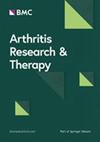血清磷脂和鞘脂通过脂质组学分析与早期骨关节炎有关
IF 4.9
2区 医学
Q1 Medicine
引用次数: 0
摘要
骨关节炎(OA)与异常脂质代谢有关,其中已观察到人类和犬滑液(SF)中磷脂(PLs)和鞘脂(SLs)水平升高。这项脂质组学研究的目的是在先前研究的基础上评估血脂水平与SF变化的密切程度。从44例关节健康供体和58例早期(eOA)或晚期OA (lOA)患者的膝关节SF和血清中提取血脂。采用电喷雾电离串联质谱法(ESI-MS/MS)对提取的脂质进行定量分析,并进行综合统计分析。人SF与血清中PL和SL的组成相似。通过对6个主要类别的91种脂质进行定量分析,发现了与oa相关的血清变化,健康对照组的水平最低,而oa队列的水平已经升高。血清PL和SL水平一般比SF高3-12倍。与健康对照组相比,eOA和lOA患者SF和血清中特异性PL种均升高,而OA患者血清中近10%的PL种均升高。在平均Outerbridge评分低于2分时检测到的显著脂质组学改变表明,某些血清PLs可以作为监测OA早期阶段的指标,甚至在放射检查可能之前。仅在OA血清中有10%的PL物种升高,我们的数据暗示存在与OA局部脂质代谢反应相似的全身反应。本文章由计算机程序翻译,如有差异,请以英文原文为准。
Serum phospholipids and sphingolipids are linked to early-stage osteoarthritis by lipidomic profiling
Osteoarthritis (OA) is associated with abnormal lipid metabolism, wherein elevated levels of phospholipids (PLs) and sphingolipids (SLs) in human and canine synovial fluid (SF) have been observed. The aim of this lipidomic study was to evaluate how closely blood lipid levels reflect changes in SF, building on previous findings. Lipids were extracted from knee SF and serum of 44 joint-healthy donors and 58 early (eOA) or late OA (lOA) patients. By electrospray ionization tandem mass spectrometry (ESI-MS/MS), we quantified the extracted lipids and conducted comprehensive statistical analyses. Human SF and serum had similar PL and SL compositions. Quantifying 91 lipid species from 6 major classes revealed OA-related changes in serum, with the lowest levels in healthy controls and elevated levels already in the eOA cohort. Generally, serum PL and SL levels were 3–12 times higher than in SF. Specific PL species were elevated in both SF and serum of eOA and lOA patients compared to healthy controls, while nearly 10% of the PL species measured were higher exclusively in the serum of OA patients. The significant lipidomic alterations that were detected at an average Outerbridge score of less than 2 suggest that certain serum PLs may serve as indicators for monitoring the early stages of OA even before radiologic detection is possible. With 10% of PL species elevated only in OA serum, our data implicate the existence of a systemic response that parallels the local lipid metabolic response to OA.
求助全文
通过发布文献求助,成功后即可免费获取论文全文。
去求助
来源期刊

Arthritis Research & Therapy
RHEUMATOLOGY-
CiteScore
8.60
自引率
2.00%
发文量
261
审稿时长
14 weeks
期刊介绍:
Established in 1999, Arthritis Research and Therapy is an international, open access, peer-reviewed journal, publishing original articles in the area of musculoskeletal research and therapy as well as, reviews, commentaries and reports. A major focus of the journal is on the immunologic processes leading to inflammation, damage and repair as they relate to autoimmune rheumatic and musculoskeletal conditions, and which inform the translation of this knowledge into advances in clinical care. Original basic, translational and clinical research is considered for publication along with results of early and late phase therapeutic trials, especially as they pertain to the underpinning science that informs clinical observations in interventional studies.
 求助内容:
求助内容: 应助结果提醒方式:
应助结果提醒方式:


